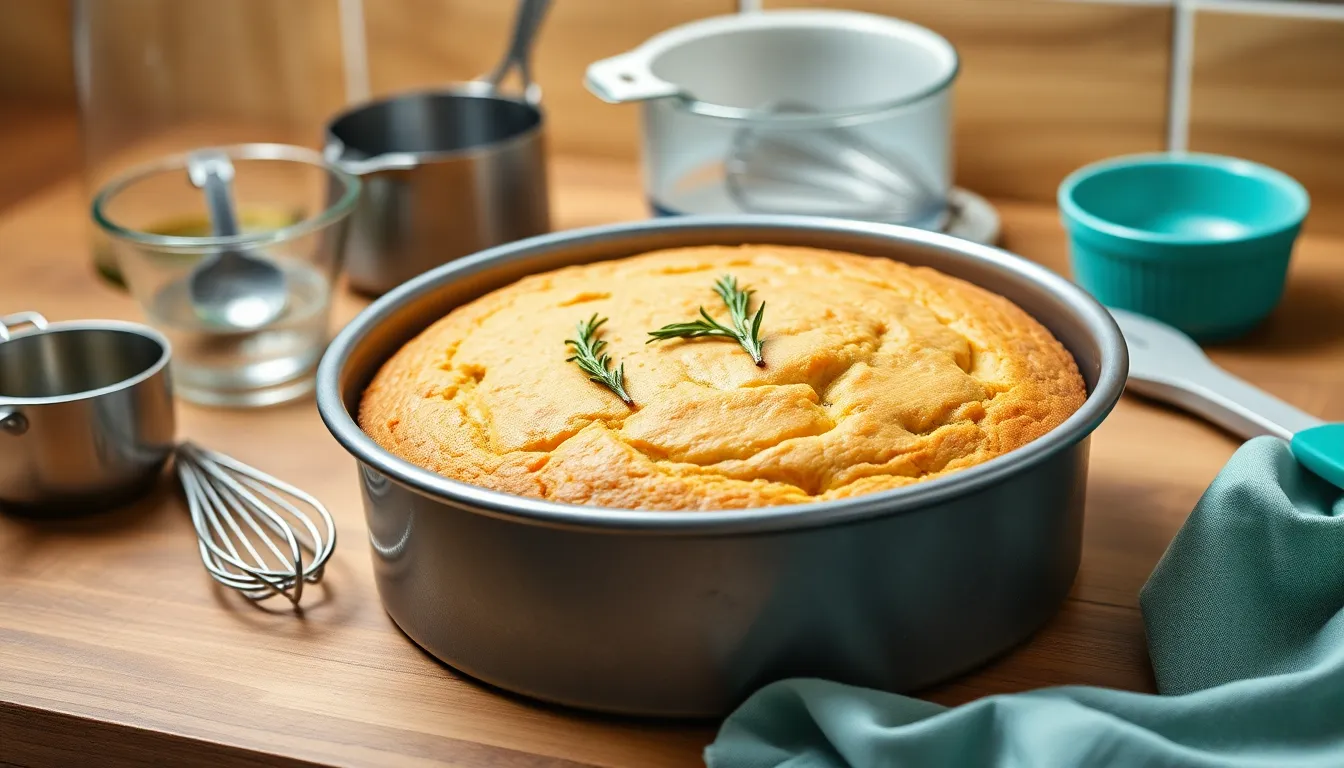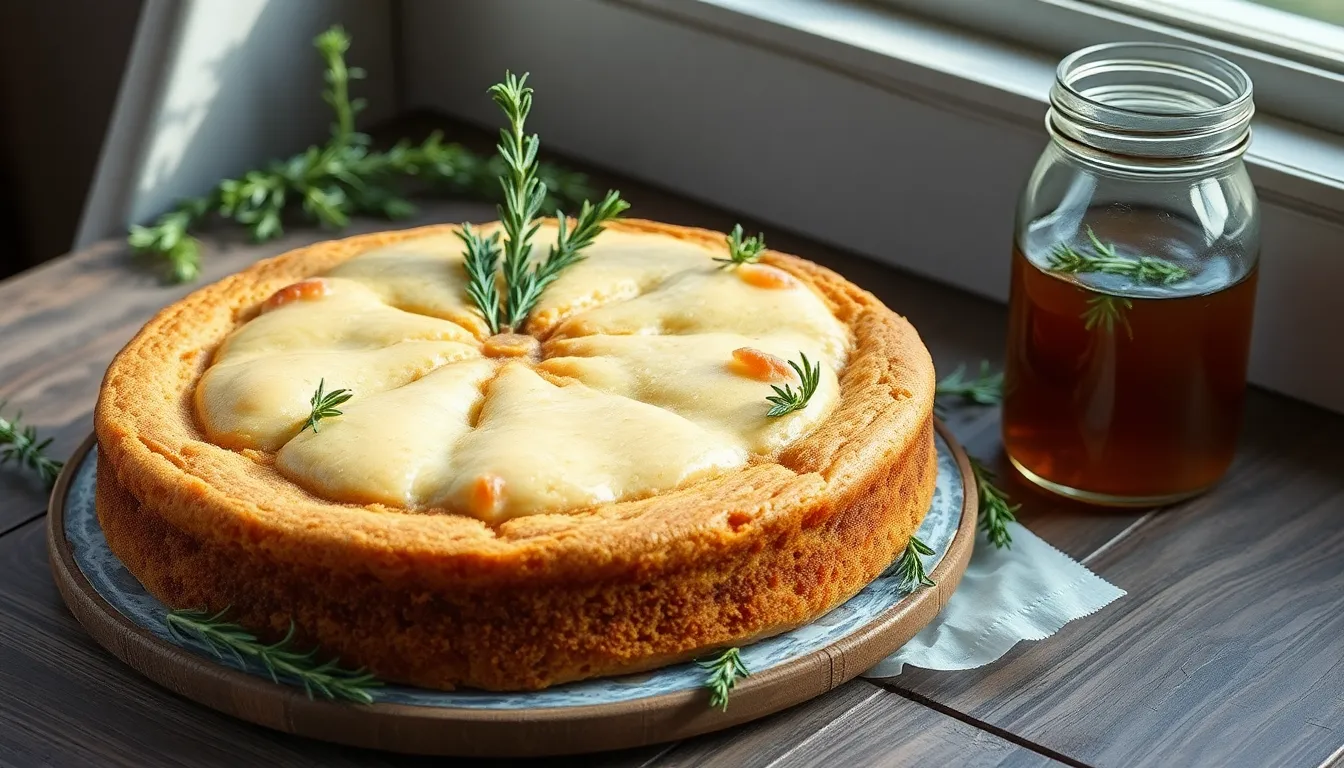We’ve discovered the perfect cake that transforms your kitchen into a Mediterranean paradise. This rosemary olive oil cake combines the earthy fragrance of fresh herbs with the rich smoothness of quality olive oil, creating a dessert that’s both sophisticated and comforting.
What makes this cake truly special is its incredibly moist texture and complex flavor profile. The olive oil doesn’t just replace butter – it elevates the entire experience with its fruity notes while the rosemary adds an aromatic punch that’ll have your guests asking for the secret ingredient.
Whether you’re hosting an elegant dinner party or treating yourself to an afternoon indulgence, this cake delivers restaurant-quality results with surprisingly simple techniques. We’ll show you how to achieve that perfect balance of flavors and that irresistibly tender crumb that makes every bite memorable.
Ingredients
We’ve carefully selected each ingredient to create the perfect balance of Mediterranean flavors in this aromatic cake. Our ingredient list ensures you achieve that distinctive moist texture and herbaceous taste that makes this dessert truly special.
For the Cake
- 1¾ cups all-purpose flour
- 1 cup granulated sugar
- 1½ teaspoons baking powder
- ½ teaspoon salt
- 3 large eggs, room temperature
- ¾ cup extra virgin olive oil
- ¾ cup whole milk
- ¼ cup fresh lemon juice
- 2 tablespoons fresh rosemary, finely chopped
- 1 tablespoon lemon zest
- 1 teaspoon vanilla extract
For the Rosemary Simple Syrup
- ½ cup water
- ½ cup granulated sugar
- 3 fresh rosemary sprigs
- 2 tablespoons fresh lemon juice
For the Glaze (Optional)
- 1 cup powdered sugar, sifted
- 3-4 tablespoons fresh lemon juice
- 1 teaspoon lemon zest
- 1 teaspoon fresh rosemary, very finely minced
Equipment Needed

Creating our rosemary olive oil cake requires exact tools that ensure optimal results and professional presentation. We recommend gathering these essential items before beginning the baking process to streamline our workflow.
Essential Baking Equipment:
- 9-inch round cake pan or springform pan for even baking
- Parchment paper for easy release and cleanup
- Kitchen scale for precise measurements (optional but recommended)
- Large mixing bowl for combining ingredients
- Medium mixing bowl for wet ingredients
- Wire whisk for smooth batter consistency
- Rubber spatula for gentle folding techniques
- Measuring cups and spoons for accurate portioning
Preparation Tools:
- Small saucepan for creating rosemary simple syrup
- Fine mesh strainer for smooth syrup consistency
- Microplane or fine grater for lemon zest
- Sharp knife for chopping fresh rosemary
- Cutting board for herb preparation
Finishing Equipment:
- Wire cooling rack for proper cake cooling
- Offset spatula for glaze application (if using)
- Pastry brush for syrup application
- Serving plate for final presentation
The springform pan offers particular advantages for this delicate cake as it allows gentle removal without compromising the tender crumb structure. Our kitchen scale ensures accuracy when measuring olive oil and flour which directly impacts the cake’s signature moist texture. Quality parchment paper prevents sticking while the wire cooling rack promotes even air circulation during the cooling process.
Prep Instructions

We begin our rosemary olive oil cake preparation by focusing on two critical steps that will ensure perfect results. These foundational preparations set the stage for our cake’s exceptional texture and aromatic flavor profile.
Preparing the Rosemary
We start by finely chopping two tablespoons of fresh rosemary to release its essential oils and maximize flavor distribution throughout our cake. The key technique involves rubbing the minced rosemary with a portion of our granulated sugar to enhance the aromatic impact and ensure even infusion into the batter.
Fresh rosemary delivers superior flavor compared to dried alternatives and provides the Mediterranean essence that defines this cake. We recommend using the tender tips of rosemary sprigs rather than the woody stems for the best texture and taste. The sugar rubbing method breaks down the herb’s cellular structure and creates a fragrant mixture that will permeate every bite of our finished cake.
Preparing the Pan
We grease our 9-inch springform or round cake pan thoroughly with olive oil to prevent sticking and enhance the cake’s flavor profile. Lining the bottom with parchment paper provides additional insurance for easy removal while maintaining our cake’s delicate crumb structure.
For optimal results we apply a light coating of baking spray over the parchment paper and greased sides. This triple protection method ensures our tender cake releases cleanly from the pan without breaking or leaving residue behind. The parchment paper serves as our safety net and allows us to lift the cake effortlessly once it has cooled for the recommended 10 minutes in the pan.
| Prep Step | Key Details |
|---|---|
| Rosemary Prep | 2 tablespoons minced, rubbed with sugar |
| Pan Prep | Olive oil greasing, parchment lining, optional baking spray |
| Pan Size | 9-inch springform or round cake pan |
| Release Method | Cool 10 minutes before transferring |
Instructions

We’ll guide you through each step to create this aromatic Mediterranean-inspired cake with perfect texture and flavor balance. Our method ensures the rosemary infuses beautifully while maintaining the cake’s signature moist crumb.
Making the Rosemary Simple Syrup
While the rosemary simple syrup is optional for this recipe, we recommend making it for enhanced flavor depth. Combine 1/2 cup water and 1/2 cup granulated sugar in a small saucepan over medium heat. Add 2 fresh rosemary sprigs to the mixture and bring to a gentle simmer, stirring until the sugar completely dissolves.
Continue simmering for 3-4 minutes to allow the rosemary essence to infuse into the syrup. Remove the saucepan from heat and strain the mixture through a fine mesh strainer to remove the rosemary pieces. Set the syrup aside to cool completely while you prepare the cake.
Mixing the Cake Batter
Start by combining 3 large eggs, 3/4 cup granulated sugar, and 1/2 teaspoon salt in a large mixing bowl. Beat the mixture with a wire whisk or electric mixer until it becomes light and pale in color, approximately 3-4 minutes.
Pour in 1/2 cup extra virgin olive oil in a steady stream while continuing to beat the mixture until well combined. The batter should appear smooth and glossy at this stage.
Add your prepared rosemary sugar mixture (from the preparation step) to the bowl and mix thoroughly to distribute the aromatic herb evenly. Incorporate 1/2 cup whole milk, 2 tablespoons fresh lemon juice, 1 tablespoon lemon zest, and 1 teaspoon vanilla extract into the wet ingredients.
Sift together 1 1/2 cups all-purpose flour, 1 1/2 teaspoons baking powder, and 1/4 teaspoon salt in a separate bowl. Gently fold the dry ingredients into the wet mixture using a spatula, mixing just until the ingredients are combined. Avoid overmixing to maintain the cake’s tender texture.
Baking the Cake
Preheat your oven to 350°F (175°C) and position the rack in the center of the oven. Pour the prepared batter into your greased and parchment-lined 9-inch springform or round cake pan, spreading it evenly with a spatula.
Place the pan in the preheated oven and bake for 35-40 minutes, checking for doneness at the 35-minute mark. Insert a toothpick into the center of the cake; it should come out clean or with just a few moist crumbs attached.
Watch for visual cues as well: the cake should be golden brown on top and pulling slightly away from the sides of the pan when fully baked. The surface should spring back lightly when touched in the center.
Finishing Touches
Remove the cake from the oven and allow it to cool in the pan for 10 minutes before attempting to remove it. This cooling period prevents the delicate crumb from breaking apart during transfer.
Carefully run a knife around the edges of the pan if using a regular round pan, then invert the cake onto a wire rack to cool completely. For springform pans, simply release the sides and transfer the cake to the cooling rack.
Once completely cooled, dust the surface generously with powdered sugar using a fine mesh sieve for even distribution. Brush the optional rosemary simple syrup over the cake surface for added moisture and flavor intensity. Garnish with fresh rosemary sprigs or candied rosemary for an elegant presentation before serving.
Make-Ahead Instructions

We love how this rosemary olive oil cake actually improves in texture and flavor the day after baking, making it perfect for advance preparation. The olive oil keeps the cake incredibly moist during storage, while the rosemary notes deepen and meld beautifully with time.
Preparing Components in Advance
Dry and Wet Ingredients Separation: We recommend mixing your dry ingredients and wet ingredients separately up to 24 hours before baking. Store the flour mixture in an airtight container at room temperature. Keep the wet ingredient mixture covered in the refrigerator. Combine both mixtures and bake within this 24-hour window for optimal results.
Rosemary Simple Syrup: This syrup can be prepared up to one week ahead of time. Store it covered in the refrigerator and bring to room temperature before using. The flavors actually intensify during storage, creating an even more aromatic finish for your cake.
Freezing Options
Baked Cake Storage: Once your cake has cooled completely, wrap it tightly in plastic wrap followed by aluminum foil. We’ve found this double-wrapping method prevents freezer burn and maintains the cake’s signature moist texture. Properly wrapped cake freezes beautifully for up to 2 months.
Thawing Process: Remove the frozen cake from the freezer and let it thaw at room temperature while still wrapped. This typically takes 4 to 6 hours depending on the thickness of your cake. Never rush the thawing process in a microwave, as this can compromise the delicate crumb structure.
Short-Term Storage
Store your finished cake covered at room temperature for up to 3 days. The olive oil base ensures the cake maintains its moisture without refrigeration. For best flavor development, we suggest serving the cake at least 4 hours after baking, though overnight resting produces even better results.
| Storage Method | Duration | Temperature | Notes |
|---|---|---|---|
| Room Temperature | 3 days | Covered | Best texture and flavor |
| Refrigerated Components | 24 hours | 40°F | Separate wet/dry ingredients |
| Frozen Whole Cake | 2 months | 0°F | Double-wrapped |
| Simple Syrup | 1 week | Refrigerated | Bring to room temperature before use |
Storage and Serving Tips

Proper Storage Methods
We recommend storing your rosemary olive oil cake covered at room temperature for up to 3 days. Place the cake in an airtight container or wrap it loosely in foil or plastic wrap to maintain its moist texture. The olive oil base naturally helps preserve moisture during storage.
For longer storage periods, we suggest freezing the cake for up to 3 months. Wrap the cooled cake tightly in an airtight container or double wrap it in plastic wrap and aluminum foil to prevent freezer burn.
Cooling and Presentation Techniques
After baking, let the cake cool in the pan for several minutes before transferring it to a wire rack. This cooling method prevents a steamed bottom and ensures even temperature distribution throughout the cake.
Once completely cooled, dust the surface with powdered sugar for an elegant presentation. We love garnishing with candied rosemary sprigs for added visual appeal and aromatic enhancement.
Serving Recommendations
Serve the cake at room temperature to showcase its full flavor profile and tender crumb. We suggest pairing it with lightly sweetened whipped cream that complements the herbaceous notes without overwhelming them.
Fresh orange segments make an excellent accompaniment, adding bright citrus notes that balance the earthy rosemary. A simple sprinkle of confectioners’ sugar also works beautifully for a minimalist presentation.
Essential Flavor Considerations
Fresh rosemary delivers superior fragrance and flavor intensity compared to its dried counterpart. We strongly recommend using fresh herbs throughout the recipe for optimal results.
| Baking Parameter | Recommended Range |
|---|---|
| Baking Time | 40-55 minutes |
| Storage at Room Temperature | Up to 3 days |
| Freezer Storage | Up to 3 months |
The baking time varies depending on your oven characteristics and the exact dimensions of your cake pan. Always test for doneness with a toothpick inserted in the center before removing from the oven.
Variations and Substitutions

Our rosemary olive oil cake serves as an excellent foundation for many creative adaptations that suit different tastes and dietary needs. We’ve tested countless variations to ensure each substitution maintains the cake’s signature moist texture and balanced flavor profile.
Citrus Enhancements
Fresh citrus transforms this cake into a bright and aromatic dessert. We recommend adding 2 tablespoons of fresh lemon juice along with 1 tablespoon of lemon zest for the classic lemon rosemary combination. Orange offers a sweeter alternative with 2 tablespoons of fresh orange juice and 1 tablespoon of orange zest creating a more aromatic twist. Tangerine provides another delightful option with similar measurements delivering a unique citrus complexity.
Herbal Substitutions
Fresh rosemary remains our preferred choice, but other herbs create entirely different flavor experiences. Dried lavender works beautifully at 1 teaspoon per batch, offering a floral note that pairs wonderfully with lemon. Fresh thyme provides an earthier profile using 2 tablespoons of chopped leaves. Bay leaves create an unexpected but sophisticated flavor when we use 3 whole leaves infused in the warm milk before straining.
Flour Alternatives
All-purpose flour delivers consistent results, but dietary restrictions often require alternatives. Gluten-free flour blends work successfully when substituted cup for cup, though we recommend adding 1 teaspoon of xanthan gum if your blend doesn’t contain it. Almond flour creates a nuttier flavor and denser texture when we replace half the all-purpose flour. Whole wheat flour adds complexity and can replace up to one-third of the all-purpose flour without compromising texture.
Sweetener Options
Granulated sugar provides the standard sweetness level, but natural alternatives offer unique characteristics. Honey requires reducing the liquid by 2 tablespoons and lowering the oven temperature by 25°F to prevent over-browning. Maple syrup works similarly with the same liquid reduction but adds a subtle autumn flavor. Both liquid sweeteners create a slightly denser but equally moist cake.
Egg Replacements for Vegan Versions
Plant-based alternatives successfully replace eggs while maintaining structure. We substitute each egg with 1/4 cup of unsweetened applesauce for added moisture. Flax eggs work excellently using 1 tablespoon of ground flaxseed mixed with 3 tablespoons of water per egg, letting the mixture sit for 5 minutes before adding. Plant-based yogurt provides richness when we use 1/4 cup per egg replacement.
Creative Add-ins
Additional ingredients enhance texture and flavor complexity. Chopped almonds or pistachios add crunch when we fold in 1/2 cup during the final mixing stage. Dried cranberries or chopped dried figs provide chewy sweetness using 1/3 cup total. Dark chocolate chips create an indulgent variation with 1/2 cup mini chips distributed throughout the batter.
Dairy Enhancements
Greek yogurt replaces milk for tangier flavor and extra richness using 1/2 cup plain Greek yogurt thinned with 2 tablespoons of water. Sour cream provides similar benefits with 1/2 cup substituted directly for the milk. These dairy additions create a denser but incredibly moist cake with enhanced flavor depth.
| Substitution Type | Original Ingredient | Alternative | Amount | Notes |
|---|---|---|---|---|
| Citrus | None | Lemon juice/zest | 2 tbsp/1 tbsp | Classic pairing |
| Citrus | None | Orange juice/zest | 2 tbsp/1 tbsp | Sweeter option |
| Herb | Fresh rosemary | Dried lavender | 1 tsp | Floral notes |
| Flour | All-purpose | Gluten-free blend | 1:1 ratio | Add xanthan gum |
| Sweetener | Sugar | Honey | Same amount | Reduce liquid by 2 tbsp |
| Eggs | Whole eggs | Applesauce | 1/4 cup per egg | Vegan option |
| Dairy | Milk | Greek yogurt | 1/2 cup + 2 tbsp water | Tangier flavor |
These variations allow us to customize the cake for seasonal ingredients, dietary preferences, or simply to explore new flavor combinations while maintaining the essential character that makes this olive oil cake so special.
Conclusion
This rosemary olive oil cake represents the perfect marriage of Mediterranean flavors and accessible home baking. We’ve shown you how simple ingredients can create something truly extraordinary when combined with the right techniques and attention to detail.
The beauty of this recipe lies in its versatility and forgiving nature. Whether you’re hosting an elegant dinner party or simply treating yourself to something special the cake delivers consistent results that’ll impress every time.
With proper storage techniques and endless customization options we’ve shared you can make this cake your own signature dessert. The investment in quality olive oil and fresh rosemary pays dividends in flavor that’ll keep your guests asking for the recipe.
Frequently Asked Questions
What makes rosemary olive oil cake different from regular cakes?
Rosemary olive oil cake uses extra virgin olive oil instead of butter, creating a uniquely moist texture with fruity undertones. The addition of fresh rosemary provides an aromatic, herbaceous flavor that brings Mediterranean flair to this dessert. This combination results in a more complex flavor profile than traditional cakes.
Can I use dried rosemary instead of fresh?
While you can substitute dried rosemary, fresh rosemary is strongly recommended for superior flavor and aroma. If using dried, use about one-third the amount called for in the recipe and rub it with sugar to help release its oils and ensure even distribution throughout the cake.
How long does rosemary olive oil cake stay fresh?
The cake stays fresh at room temperature for up to 3 days when properly covered. Thanks to the olive oil base, it actually retains moisture well and often tastes even better the day after baking. For longer storage, it can be frozen for up to 3 months.
What type of olive oil should I use for this cake?
Use extra virgin olive oil for the best flavor and quality. Choose a mild or medium-intensity olive oil rather than a robust one, as overly strong olive oil can overpower the delicate rosemary flavor. The olive oil contributes to the cake’s moist texture and adds subtle fruity notes.
Can I make this cake ahead of time?
Yes, this cake is perfect for making ahead. You can prepare the dry and wet ingredients separately up to 24 hours in advance. The rosemary simple syrup can be made up to a week ahead. The finished cake actually improves in texture and flavor after resting overnight.
What equipment do I need to make this cake?
Essential equipment includes a 9-inch round or springform pan, parchment paper, kitchen scale for accurate measurements, mixing bowls, wire whisk, and a small saucepan for the syrup. A springform pan is particularly recommended as it allows for gentle cake removal without damaging the tender crumb.
How do I know when the cake is done baking?
The cake is done when a toothpick inserted in the center comes out with just a few moist crumbs attached, and the top is golden brown. The cake should also spring back lightly when touched in the center and start to pull away slightly from the pan edges.
Can I make variations of this cake?
Absolutely! You can add citrus zest like lemon or orange, substitute herbs like lavender or thyme, or include mix-ins like nuts or dried fruits. For dietary needs, you can use alternative flours, different sweeteners, or egg substitutes for vegan versions while maintaining the cake’s signature texture.
What’s the best way to serve rosemary olive oil cake?
Serve the cake at room temperature for optimal flavor and texture. Dust with powdered sugar and garnish with fresh rosemary sprigs or candied rosemary for elegant presentation. It pairs beautifully with lightly sweetened whipped cream or fresh orange segments to complement the Mediterranean flavors.
Should I use a springform pan or regular cake pan?
A springform pan is preferred because it allows for gentle removal of the delicate cake without compromising its tender crumb structure. However, a regular 9-inch round pan works too if properly greased and lined with parchment paper. The key is ensuring easy release after cooling.







